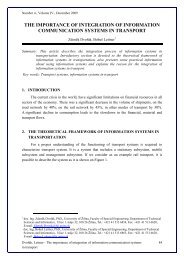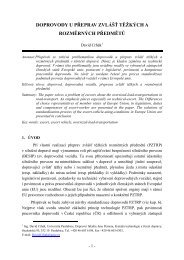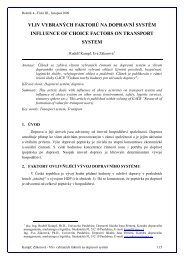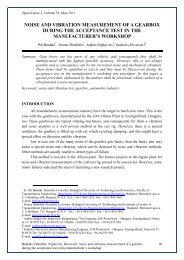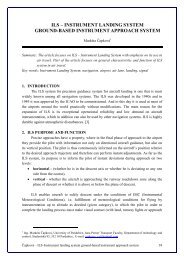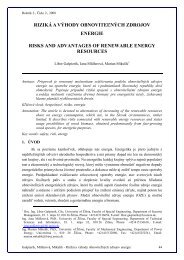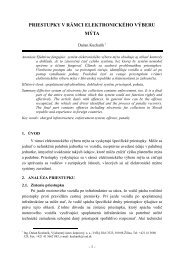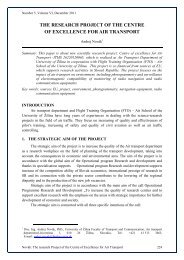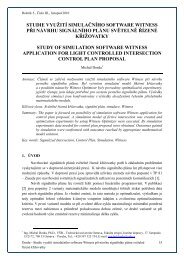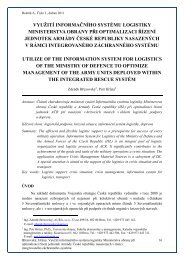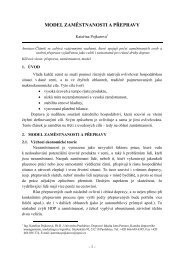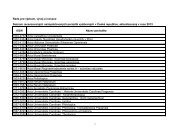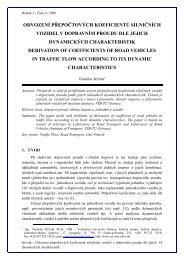monopulse secondary surveillance radar ... - Perner's Contacts
monopulse secondary surveillance radar ... - Perner's Contacts
monopulse secondary surveillance radar ... - Perner's Contacts
Create successful ePaper yourself
Turn your PDF publications into a flip-book with our unique Google optimized e-Paper software.
Number 5, Volume VI, December 2011MONOPULSE SECONDARY SURVEILLANCE RADARANTENNA FOR AIR TRAFFIC CONTROLPavel Bezoušek 1 , Vladimír Schejbal 2Summary: Secondary Surveillance Radar (SSR) play an important role in the Air TrafficControl of civilian and military aircrafts. It is frequently integrated with primary<strong>radar</strong>s having antennas of both <strong>radar</strong>s mounted on a common mast. Such anarrangement brings serious constrains on antenna size and weight. The design of aSSR antenna, for such an integrated arrangement is presented in the paper andsolutions of the related problems are described.Key words: Air Traffic Control, Monopulse Secondary Surveillance Radar (MSSR), PrimaryRadar, Interrogation Sidelobe Suppression (SLS).INTRODUCTIONFor civilian applications, the Secondary Surveillance Radar (SSR) is used for AirTraffic Control together with the Primary Surveillance Radar. SSR works by triggering atransponder in the aircraft, which generates its own coded return signal, so that the SSR signalrequires much less power than the primary <strong>radar</strong> one (1), (2), (3). The coded return signalcontains information on the identity and height of the aircraft and can possibly giveemergency and further information on aircraft.The antenna system of a modern SSR creates usually three beams: the sum, thedifference and the SLS ones. The sum beam serves for transmitting the interrogation signaland for receiving the transponders replies (targets) detection. To prevent the transponderbeing triggered by any other signal at the same frequency the transmitted signal is specificallycoded. However, the sum beam sidelobes may also cause replies from aircraft, which areclose to the <strong>radar</strong>. Therefore Interrogation Sidelobe Suppression (ISLS) is used to prevent thesame aircraft appearing on several bearings simultaneously via sidelobes. Control pulsestransmitted by the SLS beam which pattern is omnidirectional with a null in the direction ofthe sum mainlobe. Hence the control pulse magnitude in space is less than those of theinterrogation ones within sum mainlobe but it is of a greater magnitude in the sidelobe region.The transponder will respond only when the interrogation pulses are greater of the controlpulse by 6 dB or more. Similarly the SLS beam is used for rejection of false received signalsthrough the mainbeam sidelobes (RSLS). The required SLS beam pattern is achieved bydriving the central element (backfill antenna) with half the input power of which a smallproportion is fed to the remaining elements in antiphase with the central element.1 prof. Ing. Pavel Bezoušek, CSc., University of Pardubice, Faculty of Electrical Enineering and Informatics,Department of Electrical Engineering, Studentska 59, 532 10 Pardubice, Czech Republic, Tel.: +420 466 036035, E-mail: pavel.bezousek@upce.cz2 prof. Ing. Vladimir Schejbal, CSc., University of Pardubice, Jan Perner Faculty of Transport, Department ofElectrical Engineering, Electronics and Signalling in Transport, Studentska 59, 532 10 Pardubice, CzechRepublic, Tel.: +420 466 036 293, E-mail: vladimir.schejbal@upce.czBezoušek, Schejbal: Monopulse Secondary S<strong>surveillance</strong> <strong>radar</strong> Antenna for Air Traffic Control 21
Number 5, Volume VI, December 2011An accurate aircraft bearing measurement is ensured by using Sum/DifferenceMonopulse. The replies from the aircraft are received simultaneously via a sum and adifference patterns. The difference pattern has a sharp null at the center of the sum mainlobe.By exploiting the ratio of the difference and the sum beams the azimuth bearing can be foundaccurately even in the case of receiving only one or a few replies.The most direct way of correlating primary and <strong>secondary</strong> data is to mount bothantennas on one rotating shaft. To prevent excessive weight and wind loads on turning gear,the SSR antenna should be made as small and light as possible. For many years the standardconfiguration for interrogators consisted of a linear array (commonly called a hog troughbecause it resembles an animal feeder) and a stationary omnidirectional antenna. Today, toreduce signals reflected from the ground and surrounding objects, which can give rise tofurther interrogations and false plots at different azimuth angles, a Larger Vertical Aperture(LVA) is used. LVA with a shaped aperture distribution can give a vertical radiation patternallowing balance between reducing ground reflections and providing sufficient low anglecoverage.The paper describes an attempt to integrate antennas into one antenna unit for primaryand <strong>secondary</strong> <strong>radar</strong>s.1. SSR ANTENNAThe SSR antenna with a shaped aperture distribution is a planar array with operatingfrequencies of 1,03 and 1,09 GHz. Suppose that antennas of an array are located at points r 1 ,r 2 , and so on. We obtain the total pattern of the antenna array by adding the electric fieldsradiated from any antenna. If the individual antennas (elements) have identical elementpatterns, we can separate the pattern into a product of an element pattern and an array factor F(3), (4), (5), (6). Then the array factor is given by the following equationM Njk(md xTx+ ndyTy)+ jψmnF = ∑∑Imnem=−M n=−N(1)where the coordinate system is considered according to Fig. 1, I mn are amplitudes, ψ mn arephases, k = 2π /λ, λ is a wavelength, d x and d y are the element spacing along x and y axes,T x = sin Θ cos Ω and T y = sin Ω.Bezoušek, Schejbal: Monopulse Secondary S<strong>surveillance</strong> <strong>radar</strong> Antenna for Air Traffic Control 22
Number 5, Volume VI, December 2011Fig. 1 - Array coordinate system1.1 Azimuth PatternInthe horizontal plane, accurate determinationn of target angle and minimizationn of falsetargets are very important. There are three azimuth patterns to be generated, sum, differenceand control, whichh are interdependent since they employ the same elevation boards and someof the same powerdivider networks. The sum pattern parameters determine antennaa length.The sidelobe level could be theoreticallyachieved using a Taylor distribution. However, thecentral elevation board of the array has to be fed with less power due to the form of the feednetworkand the interrelationn of the sum and control patterns. Moreover, manufacturingtolerances cause perturbationsof amplitudes and phases and increase the sidelobe level.For integration of SSR and primary<strong>radar</strong> antennas, somecompromise design should bedone. Therefore, 27 elevation boards with spacing of 198 mm have been used. The optimum(narrowest) beamwidth for a given sidelobe level occurs when all sidelobes are of equal level.The ideal Taylor line source, although unrealizable,provides such a pattern. For sumpatterndesign, the realizable amplitude Taylor distribution with uniform phase according to (3), (4),(5), (6) has been computed with -40 dB maximum sidelobes andn = 6.Tocreate three azimuth patterns, itis necessary to modifythe Taylor distribution and afeed network. It was proved that the same amplitude and phase distribution can be used foredge elements (n = -13, -12, ... , -2, 2, 3, ... , 13)both for the sum and control SLS anddifference and modified the central threee element distributionss (for n = -1, 0, 1). That is anacceptable design with the feed networkshown inFig. 2. A Wilkinson power divider andbranch-line couplers are designed using stripline transmission lines (7), (8).Fig. 2. - Feed network. 1 – Wilkinson power divider, 2 to6 Branch-line couplersBezoušek, Schejbal: Monopulse Secondary S<strong>surveillance</strong>e <strong>radar</strong> Antenna for Air Traffic Control 23
Number 5, Volume VI, December 2011The resulting distribution modifications are results of optimizations consideringproperties of all three beams (Sum, Difference and SLS). This distribution is very importantto keep sum sidelobe level as low as possible and simultaneously to achieve the higherefficiency (gain). In fact, the mentioned modification increases slightly the sidelobe level.The resulting radiation patterns (or better array factors) considering efficiencies(directivities) and the backfill antenna are shown in Fig. 3. It is clear that for sum sideloberegion, the SLS beam pattern is approximately greater by 20 dB than the sum beam pattern.That is sufficient for sidelobe suppression. For near axis angles the SLS beam is lower by28.5 dB than the sum beam for angles in vicinity of ω = 0 o . That is satisfactory as well.The radiation patterns are given both by array factor and element patterns. That willdecrease levels both for elevation as well as azimuth pattern. Considering that the individualelement gains g e are the same the gains of individual beams are governed by computedefficiencies. Obviously, the gains will be decreased by feed network losses.Fig. 3 - Array factors of individual beam considering efficiencies (directivities) and thebackfill antenna for f =1,06 GHz1.2 Elevation PatternThe SSR antenna design considers 8 elements with spacing of 180 mm for verticalnetwork due to primary <strong>radar</strong> antenna and horizontal plane level of -2 dB. To computeamplitude and phase distributions, a Woodward synthesis has been used (3), (4), (5), (6). Infact, the Woodward synthesis is not optimal and another method could be used but fromtolerance point of view the Woodward synthesis is much more suitable. Moreover, theWoodward synthesis could be easily modified, i.e. sample values could be changes thanks tofact that the synthesized pattern exactly equals the desired pattern at the sample points due tothe orthogonality of the component beams.The array factor design is shown in Fig. 4. The used values for pattern samplingoptimization are given by crosses, the dashed line shows values corresponding to samplingand the solid line is shifted array factor [dB] for 8 elements with spacing of 180 mm.Bezoušek, Schejbal: Monopulse Secondary S<strong>surveillance</strong> <strong>radar</strong> Antenna for Air Traffic Control 24
Number 5, Volume VI, December 2011The elevation coverage diagram for 8 elements with spacing of dx = 180 mm isshown in Fig. 5. The solid line shows values without ground reflection effects. Thedashed line depicts ground reflection effects considering very rough assumption forreflection coefficient of Γ = -1, which is approximately valid for θ < 4 0 . Therefore a“null” for angle θ about 3 0 is extremely doubtful. In fact, the absolute value ofreflection coefficient for vertical polarization is sharply decreasing. Moreover, therandom changes, such as terrain variations and vegetation, could be substantial.Fig. 4 - Elevation array factor for N = 8 elements, f =1,06 GHz, dx = 180 mmFig. 5 - Elevation coverage diagram for 8 elements with dx = 180 mm and f =1,06 GHz2. FEED NETWORKThe SSR antenna consists of 216 irradiating elements, arranged into 27 verticalcolumns of 8 elements. The vertical distribution of amplitude and phase creating antennaelevation pattern, common to all three horizontal beams are accomplished by 27 identicalvertical feeders. The vertical feeders are fed by a 3in/27out horizontal feeder generating thethree beams: the sum, the difference and the SLS ones. Due to low insertion loss requirementsthe whole SSR antenna feeder is designed basically as a suspended stripline network.2.1 Vertical feederThe vertical feeder consists of 7 branch line couplers (see fig. 6) of different powerdivisions connected by striplines, providing the appropriate phase and amplitude distribution.Bezoušek, Schejbal: Monopulse Secondary S<strong>surveillance</strong> <strong>radar</strong> Antenna for Air Traffic Control 25
Number 5, Volume VI, December 2011A B C D E F G HV1 V2 V3 V4V5V6V7inputFig. 6 - Block diagram of one vertical feeder. The ports A, …, H are connected to the antennaelements.The vertical feeders are mounted at the front face of the primary <strong>radar</strong> antenna so thereare severe constrains on their dimensions. To save the scare space the branch line couplersshould have been dramatically distorted obtaining finally the form, shown in the Fig. 7. Theactual reference planes of the line junctions were determined from the reflection coefficientsS ii minima frequencies measurement on the individual dividers.323Z B2Z BZ AZ AZ AZ A4Z B14Z 0Z B1Fig. 7 - The vertical feeder branch line couplers of the distorted form.The vertical feeder dimensions minimization led also to a two layer design sketched inthe Fig. 8. In the first layer the dividers No. 1 to 4 are placed, which outputs are directlyconnected to the eight antenna elements. The second layer contains the rest three dividers andthe feeder input port. Thanks to the all described modifications the vertical feeder is only85 mm in depth.Bezoušek, Schejbal: Monopulse Secondary S<strong>surveillance</strong> <strong>radar</strong> Antenna for Air Traffic Control 26
Number 5, Volume VI, December 2011Feedth‐ trough conductorPCBs1stlayer2ndlayerStriplinesDielectric bushingFig. 8 - The layered design of the vertical feeder.2.2 Horizontal feederThe horizontal feeder network comprises 27 power dividers of various types. It issegmented into three blocks: one central feeder block and two lateral ones. The central blockdiagram is shown in the Fig. 2. Consisting of six power dividers/combiners it combines threeinputs for sum, difference and SLS beam signals and distributes them to six output ports forthree central vertical feeders, for the two lateral feeder blocs and for the backfill antenna.Only the divider No. 1 is a Wilkinson type power divider, the rest ones are of the branch linetype.Verticalfeeders‐13 ‐12 ‐11 ‐10 ‐9‐8‐7‐6 ‐5‐4‐3‐2‐1‐0 +1+2 +3+4 +5+6 +7+8 +9+10 +11+12 +13Lateral feeder block ‐ leftLateral feeder block ‐ rightTo thebackfillantennaCentral feeder blockSUM Difference SLSFig. 9 - Schematic diagram of the horizontal feederThe two lateral feeder blocks are identical but mirror-oriented to provide a symmetricalexcitation of the vertical feeders (Fig. 9). The lateral feeder block is an 1/12 divider andconsists of eleven branch line power dividers. Due to a non-uniform signal amplitudedistribution at the twelve outputs the branch line dividers output power ratios have a largespan from 3 to 11 dB. Particularly the dividers with low coupling are extremely sensitive totolerances of the high impedance segments Z B (see the Fig. 7). Also the divider network isarranged in a quite nonstandard way.Bezoušek, Schejbal: Monopulse Secondary S<strong>surveillance</strong> <strong>radar</strong> Antenna for Air Traffic Control 27
Number 5, Volume VI, December 2011CONCLUSIONIn the paper the MSSR antenna design is described. To create three azimuth patterns, itis necessary to modify the Taylor distribution and a feed network. It was proved that the sameamplitude and phase distribution can be used for edge elements both for the sum and controlSLS and difference and modified the central three element distributions. The resulting arrayfactors considering efficiencies (directivities) and the backfill antenna are shown in Fig. 3.The Woodward synthesis has been used for elevation pattern as it is much more suitable fromtolerance point of view. The elevation array factor design is shown in Fig. 4.Severe dimension constrains on antenna parts, following from the integration with theprimary <strong>radar</strong> antenna requirements were solved using distorted form of branch line couplersand the layered feeder structure.The research of the MSSR antenna is supported by the Czech Ministry of Industry andTrade project No. FR-TI2/480.REFERENCES(1) ALEXANDER, M. J. The Design and Performance of a Large Vertical Aperture Antennafor Secondary Surveillance Radar. GEC Review, vol. 4, no. 2, 1988, pp. 109 – 117.(2) SKOLNIK, M. I. Radar Handbook, 2008, N. York, McGraw-Hill.(3) VOLAKIS, J. L. Antenna Engineering Handbook, 2007, N. York, McGraw-Hill.(4) MILLIGAN, T. A. Modern Antenna Design, 2nd ed. 2005, Hoboken, John Wiley & Sons.(5) MAILLOUX, R. J. Phased Array Antenna Handbook, 2nd ed. 2005, Norwood, ArtechHouse.(6) BALANIS, C. Modern Antenna Handbook, 2008, Hoboken, John Wiley & Sons.(7) COLLIN, R. E. Foundations for Microwave Engineering, 2005, Hoboken, John Wiley &Sons.(8) POZAR, D. M. Microwave Engineering, 2005, Hoboken, John Wiley & Sons.Bezoušek, Schejbal: Monopulse Secondary S<strong>surveillance</strong> <strong>radar</strong> Antenna for Air Traffic Control 28




